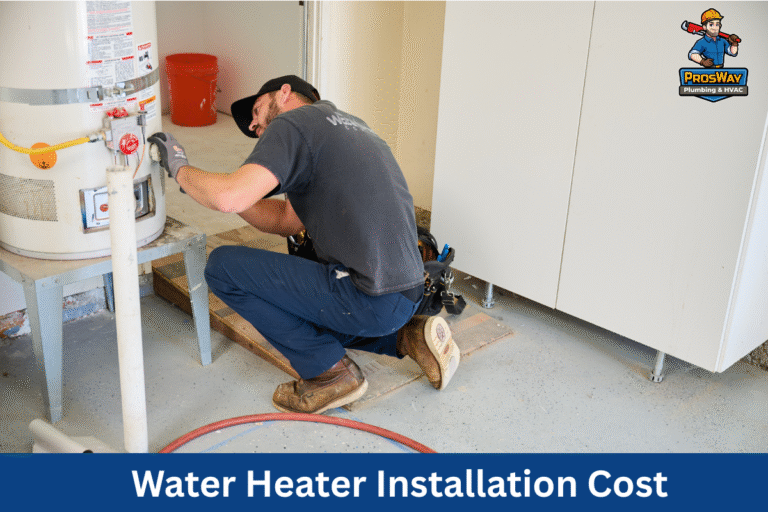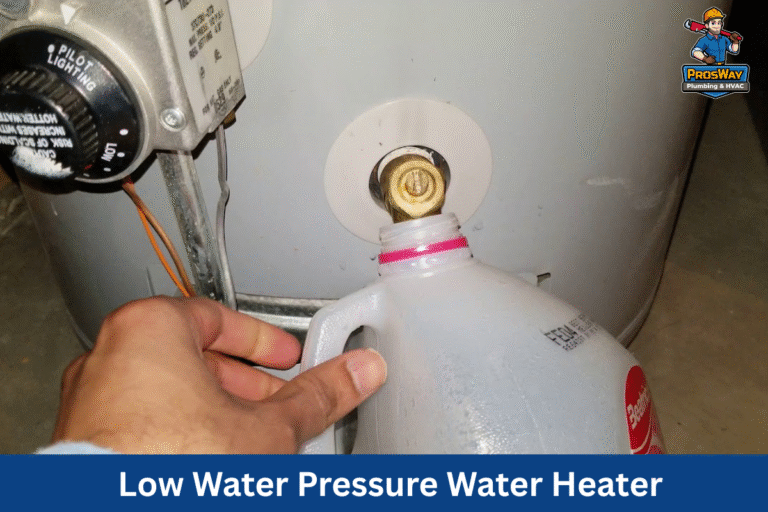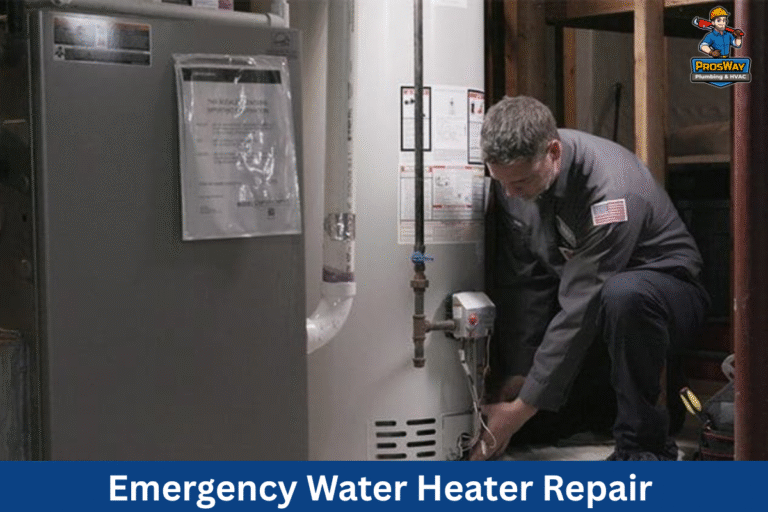The pressure valve on the water heater is the key to guarantee the safety of your home, as it prevents the tank from becoming a dangerous pressure bomb by releasing water when levels get too high. However, when the water heater pressure valve is leaking, it’s not something you should ignore.
Sometimes it signals a simple pressure imbalance, while other times it points to a failing valve or even overheating inside the tank. The good news is, today’s post explains the causes of the leak, the steps to fix the pressure relief valve leak, and when to call a professional plumber.
What is a Water Heater Pressure Relief Valve?
The temperature and pressure relief valve, often abbreviated as T&P valve, is a small yet vital safety device on both gas and electric water heaters.
- Location: You’ll typically find it on the top or side of the water tank, connected to a discharge pipe that runs down the side of the heater to the floor.
- Purpose: Its job is to automatically open if the water temperature climbs above 210°F or the pressure exceeds 150 psi. This prevents excessive pressure from building inside the tank.
Without this valve, excessive heat or pressure could damage the plumbing system or even cause the tank to rupture.
Common Signs Your Water Heater Pressure Valve Is Leaking
Spotting a leak early can save you from bigger problems like flooding or full system failure. Here are the most common warning signs:
- Water pooling at the base of the heater: Even a small puddle indicates a drip from the discharge pipe or valve connection.
- Drips or trickles from the discharge pipe: Continuous dripping means the valve is opening frequently, often due to excess pressure.
- Unusual noises: Sounds like hissing, gurgling, or whistling often point to escaping steam or pressure release.
- Sudden pressure changes in hot water: If faucets sputter or pressure drops unexpectedly, the valve may be opening under stress.
Catching these symptoms early helps avoid further damage, and more importantly, keeps your water heater operating safely.
Why Is the Pressure Relief Valve Leaking? (Common Causes)
There are several reasons why you might see water leaking from a water heater pressure valve. Here are the most frequent causes:
High Water Pressure in the Plumbing System
The T&P valve may release water regularly if your home’s water pressure is consistently above 80 psi. This isn’t valve failure, it’s the system doing its job. Installing a pressure-reducing valve (PRV) can solve this issue.
Excessive Water Temperature
A thermostat set too high can cause overheating. Water hotter than 120°F increases the risk of scalding and forces the valve to open more often.
Thermal Expansion
In a closed-loop plumbing system, heated water expands with nowhere to go, creating excess pressure. Without an expansion tank, the T&P valve ends up venting this pressure repeatedly.
Sediment Buildup in the Tank
Over time, sediment, minerals, and debris accumulate at the bottom of the tank. This leads to overheating, creating extra pressure that forces the valve to leak.
Corroded or Aging Valve
Like any mechanical part, the T&P valve wears down. Corrosion, faulty seals, or misalignment prevent it from sealing properly, leading to constant dripping.
Improper Installation or Defective Valve
The valve may never seal correctly if it was installed at the wrong angle or cross-threaded. In some cases, the valve itself is defective from the start and needs replacement.
How to Fix a Water Heater Pressure Valve Leaking?

Fixing a hot water heater pressure valve leaking requires careful steps to ensure both safety and effectiveness. Here’s how homeowners and professionals approach water heater repair:
1. Turn Off the Power and Water Supply
- Electric water heater: Switch off the breaker.
- Gas water heater: Turn the gas valve to OFF.
- Shut off the cold water supply valve above the heater.
This prevents scalding hazards and keeps new water from entering the tank.
2. Check the Water Pressure
Attach a pressure gauge to a faucet or hose bib. If pressure exceeds 80 psi, a PRV should be installed on the main supply line. Constant high pressure is a major reason for recurring T&P leaks.
3. Inspect the Discharge Pipe
The discharge pipe runs from the T&P valve to the floor. Look for drips, puddles, or continuous flow. The issue is often thermal expansion if water pools only during heating cycles. A steady drip, however, usually indicates a faulty valve.
4. Flush the Water Heater
Sediment and debris trapped in the valve can prevent it from sealing. Draining a few gallons from the tank (using a bucket and wrench) may clear obstructions. Always let water cool before flushing.
5. Test the Valve Directly
Lift the test lever on the valve to ensure it opens and reseats properly. The valve is stuck open and needs replacement if water keeps flowing after releasing the lever.
6. DIY Repairs Homeowners Might Handle
- Adjust the thermostat to 120°F.
- Install a hose cap temporarily on the discharge pipe to contain minor drips.
- Flushing sediment from the tank.
7. When to Call a Professional
Contact a licensed professional plumber if the valve needs full replacement or if the tank shows signs of corrosion. A pro will safely drain the tank below valve level, unscrew the old valve, apply plumber’s tape or pipe dope, install and align the new valve, then restore water and power. They will also run a function test to confirm the repair.
Tips to Prevent Future Leaks
A leaking hot water heater pressure valve can often be prevented with proper maintenance and monitoring. Here’s what to do:
- Annual maintenance: Flush the tank yearly to clear out sediment and mineral buildup.
- Pressure management: Install a PRV if your home’s supply line pressure is high.
- Thermostat check: Keep water temperature at 120°F. This prevents overheating while saving energy.
- Expansion tank: If you have a closed-loop plumbing system, adding an expansion tank prevents excess pressure during heating cycles.
- Routine inspection: Look for drips, puddles, and unusual noises. Early detection avoids bigger failures.
When to Replace Your Water Heater?

Even with maintenance, no water heater lasts forever. Most tank water heaters last 8–12 years. As they age, valves corrode, threads weaken, and the tank itself becomes prone to leaks.
Signs replacement is better than repair:
- The water heater is over a decade old and leaking regularly.
- The T&P valve keeps failing even after replacement.
- Rust or corrosion spreads across the tank body.
- Sediment buildup is so severe that flushing no longer helps.
In these cases, installing a new water heater is safer and more cost-effective than constant valve repairs. A licensed professional can help you decide whether repair or full replacement makes the most sense.
The Bottom Line
The pressure relief valve is one of the most important safety mechanisms in your water heater. Leaks may look like a small nuisance, but they often point to bigger issues such as high water pressure, overheating, or valve failure. Acting early prevents puddles, corrosion, and even serious safety risks. Regular maintenance, proper pressure control, and timely repairs extend the life of both the valve and the heater.
Need Expert Help With a Leaking Pressure Valve?
ProsWay Plumbing & HVAC has licensed professionals ready to inspect, repair, or replace your water heater. From testing the T&P valve to installing expansion tanks or new units, we handle everything safely and efficiently. Call us now at (862) 260-5870 or Book Online Today for reliable water heater service and peace of mind.









